How to Snowshoe Safely: 8 Tips from an Expert in the Field
By Dallas Glass, Deputy Director, Northwest Avalanche Center
The cold, crisp air hits you as you slowly set one foot in front of the other moving through a quiet forest covered in snow. These are the winter days we all dream of. But, if we take a step back, it’s important to think of the preparation that goes into these trips. Where do we begin and what should we know to ensure we are making the most informed decisions for a day out this winter? To get you prepared for the upcoming season, here are eight tips from our team at the Northwest Avalanche Center on how to snowshoe safely. Whether you’re new to snowshoeing or seeking to build your knowledge, this advice will help you enjoy your winter adventures to the fullest.
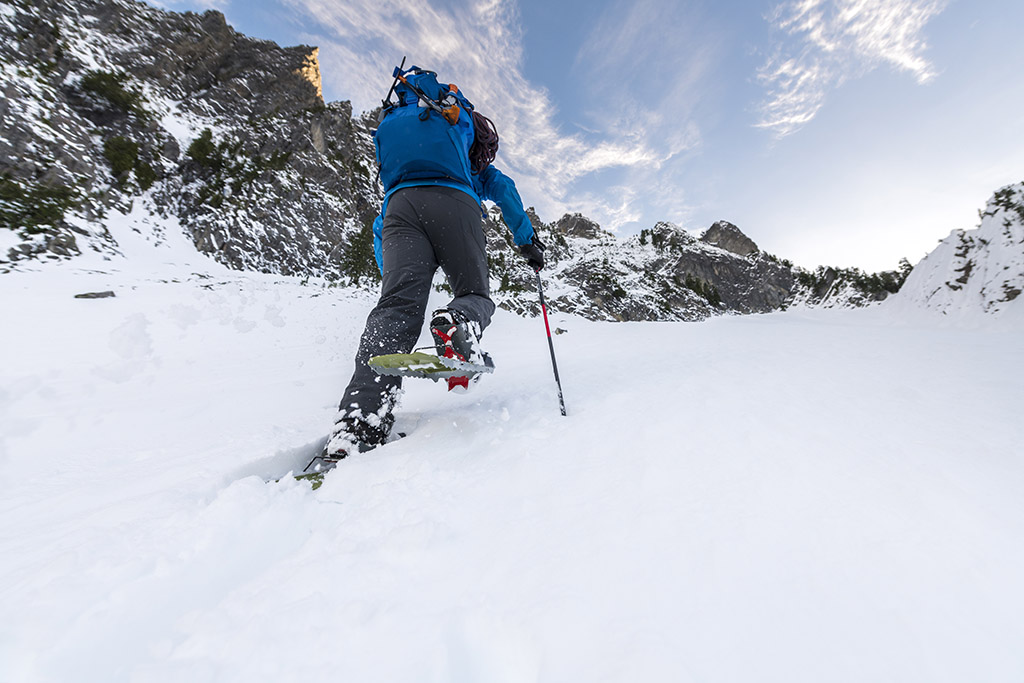
Realize snowshoeing is different than hiking
If you’re an avid summer hiker, you’ve likely thought about snowshoeing as a way to hike year–round. It’s a natural transition, and while the two sports share many of the same techniques and gear, it’s important to recognize snowshoeing requires unique skills. Unlike hiking, snowshoeing often lacks marked or packed-in trails. Additionally, winter can bring more challenging weather conditions as well as the potential risk of avalanches. Even the physical act of walking in the snow makes snowshoeing its own unique sport.
Pro tip: Join a Forest Service/Park Service Ranger led snowshoe walk for your first time out. Contact your local ranger station for more information.
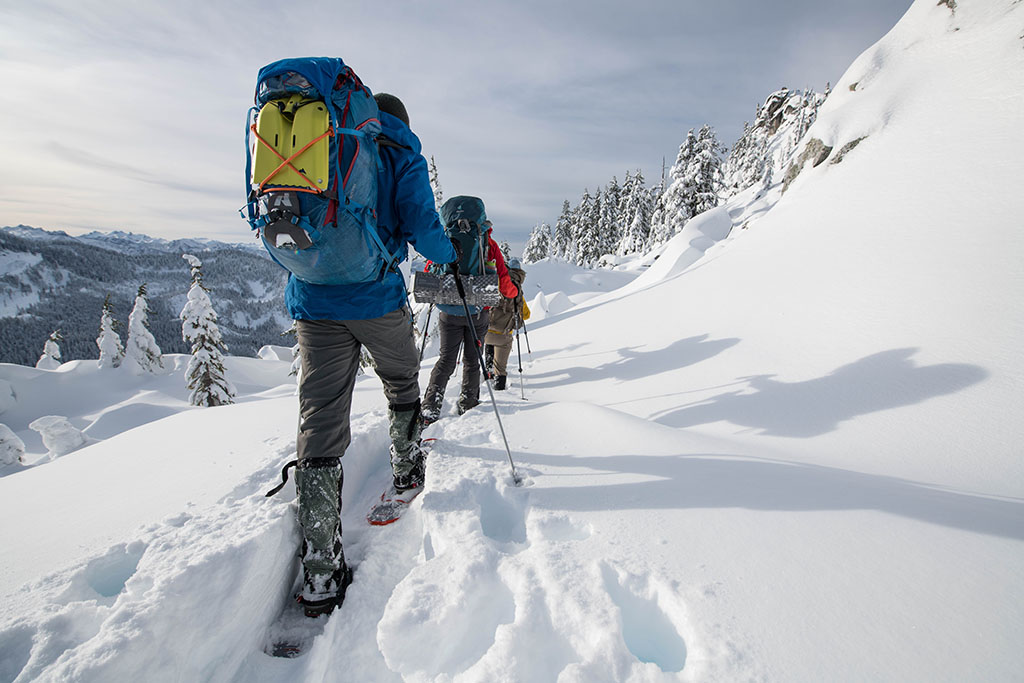
Ditch the summer trail
We’ve all been taught, “Don’t cut the switchback,” and “Stay on the trail.” While this is sound advice during warmer months, when snow buries the summer trails, it’s your opportunity to go exploring—and, in fact, it can be safer to do so. Unless you’re at a managed snowshoe area with marked routes, it’s best to research the safest route to get to your chosen destination. Summer trails can lead you through avalanche-prone terrain (avalanches can be fatal), so it’s important that you don’t follow them blindly. Instead, you’ll want to navigate by observing the terrain in front of you. This often means avoiding steeper slopes, traveling around avalanche-prone terrain (more on that later), and taking the path of least resistance to make your travel safer and more efficient.
Pro tip: Take a class to learn how to navigate in the wilderness, read a topo map, and use a GPS.
Pro tip: Use maps and online mapping tools to identify lower angled slopes and anticipate your off-trail travel route.
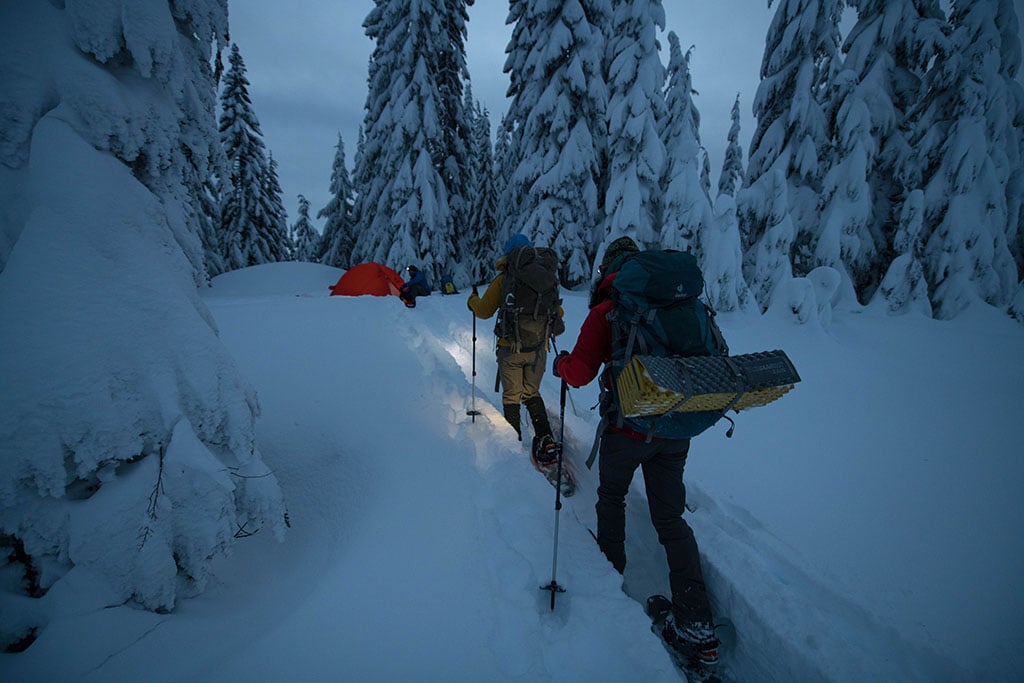
Think like an onion
What? Thinking like an onion means dressing in layers so that you can put them on and peel them off when you need to. One of the most important ways to achieve a successful (and enjoyable) snowshoe adventure is to manage your body temperature and prevent yourself from sweating. Sweating causes you to become dangerously cold even when you stop for short rest breaks. To keep yourself dry, you’ll want to shed layers as you heat up, thus staying slightly cool but not cold while walking. When you stop for a break, immediately put your warm layers back on and save all that body heat you’ve rightfully earned. By adjusting layers for your activity level and the weather, you can manage to stay comfortable and dry all day.
Pro tip: Be bold, start cold! If you’re comfortable when you’re standing around, take off one layer prior to hiking. This will prevent you from getting too hot 10 minutes down the path.
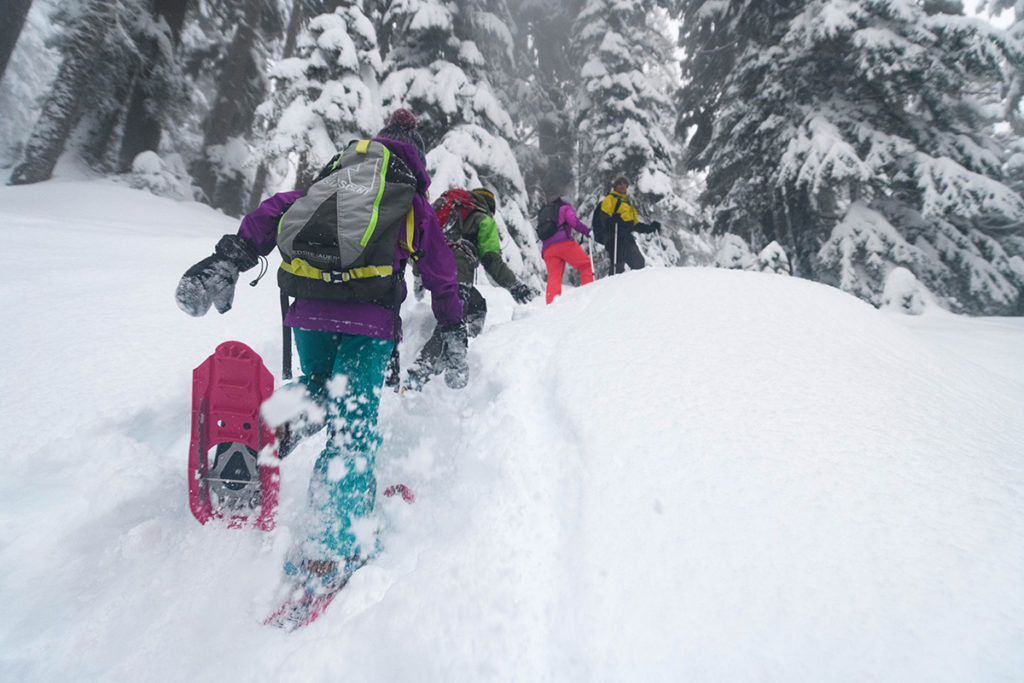
Check the mountain weather
We’re all accustomed to looking at the weather forecast before taking a summer hike, but that habit is even more important during the winter. Challenging weather conditions can greatly increase the difficulty and safety risks of a snowshoe outing. Poor visibility, extreme cold and wet conditions are just a few of the issues that can turn a fun trip, into a dangerous one, when you aren’t prepared. Check with the National Weather Service for up-to-date information on the mountain conditions you can expect. If you don’t have the skills and experience to deal with adverse weather conditions consider waiting for another day.
Pro tip: Look to your local avalanche center for the weather forecast. Most avalanche centers provide detailed mountain weather forecasts as a part of their daily avalanche information. These may be more detailed and better tailored to where you’ll be snowshoeing.
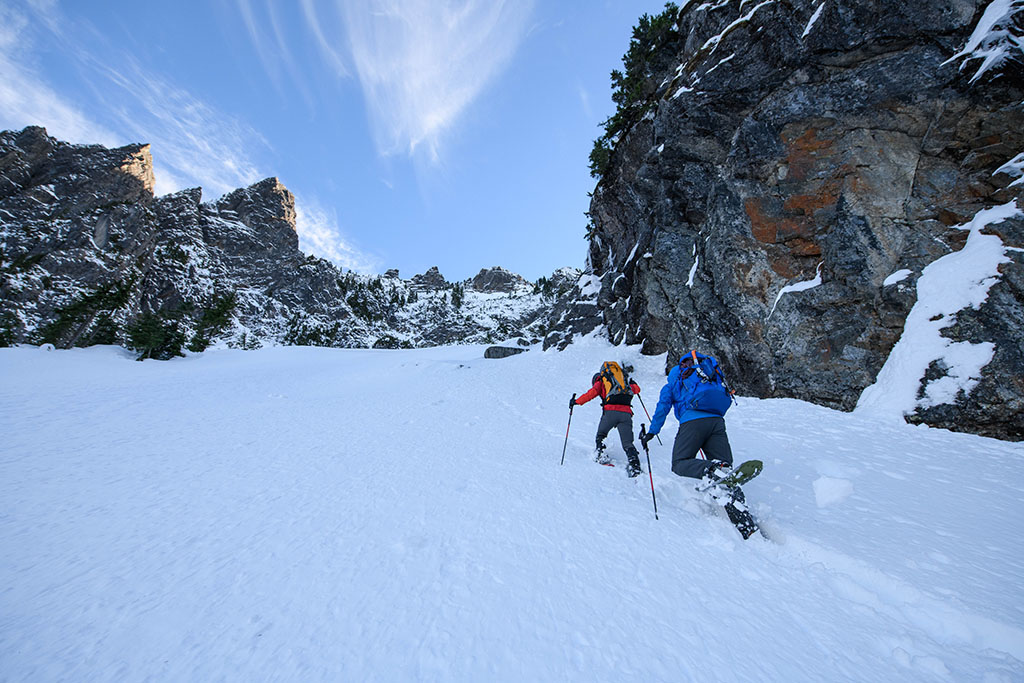
Be avalanche aware (and educated)
The truth is, if you are snowshoeing in mountainous terrain or areas with snow-covered slopes around you, there is a risk of avalanches. An avalanche is a mass of snow moving downhill. Avalanches happen when the snow on a particular slope is unstable and something causes that snow to release. There are all kinds of things that can cause that release, including you! While there is a lot to learn about avalanches and traveling safely through the winter mountains, a great place to start is your local avalanche center.
Many popular mountainous areas in the US and Canada are monitored by avalanche centers that produce daily avalanche “forecasts.” Learning to read these reports gives you some information that you can factor into your route-planning. The centers also promote basic avalanche awareness and education. Like the weather, avalanche forecasts change daily, so you’ll want to check the latest forecast before heading into the mountains.
Avalanche education falls beyond the scope of this blog, but we can’t express enough the value in being avalanche aware. While many of us don’t intend to snowshoe near avalanche-prone areas, we still need to educate ourselves to be able to correctly identify and avoid avalanche terrain. Learn more by taking an online tutorial and attending an avalanche awareness program.
Pro tip: Many avalanche centers offer free avalanche awareness classes. Check with your local avalanche center for one in your area.
Pro tip: Read the avalanche forecast frequently. It will help you build context and confidence in conditions and how to travel safely.
A note on safety gear: If you and your group are traveling in or near avalanche-prone terrain, you should carry avalanche rescue gear—and know how to use it. Every member of the team must wear an avalanche transceiver, and carry a probe and shovel. You can take a single–day course in avalanche rescue from local professionals.
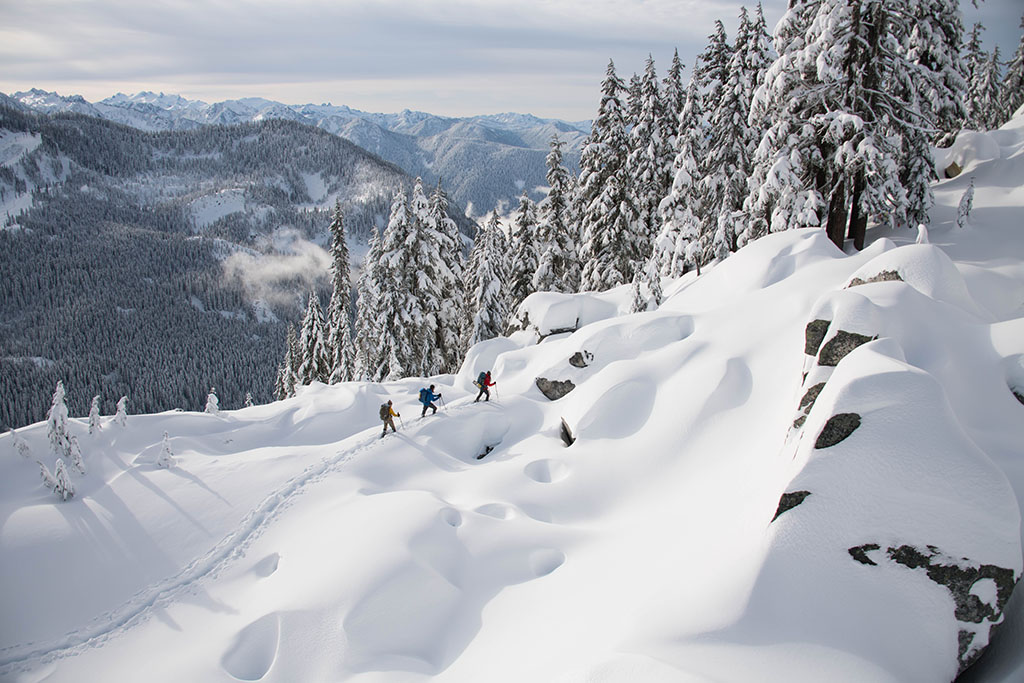
Bring a communication device
Getting away from the stress of our computers and phones is often one of the draws for wilderness recreation. As much as you may want to disconnect, before you leave high tech at home, consider how you will communicate with the outside world if you or someone in your group gets injured or lost). Satellite communication devices and sometimes even cell phones have become critical pieces of safety gear. In addition, it’s important to provide a detailed trip plan to family or friends. These things add important levels of security in the unpredictable winter environment.
Pro tip: If you travel off the grid, consider buying a two-way communication satellite device. These can greatly assist in rescues and keep your loved ones informed about how you’re doing on longer trips.
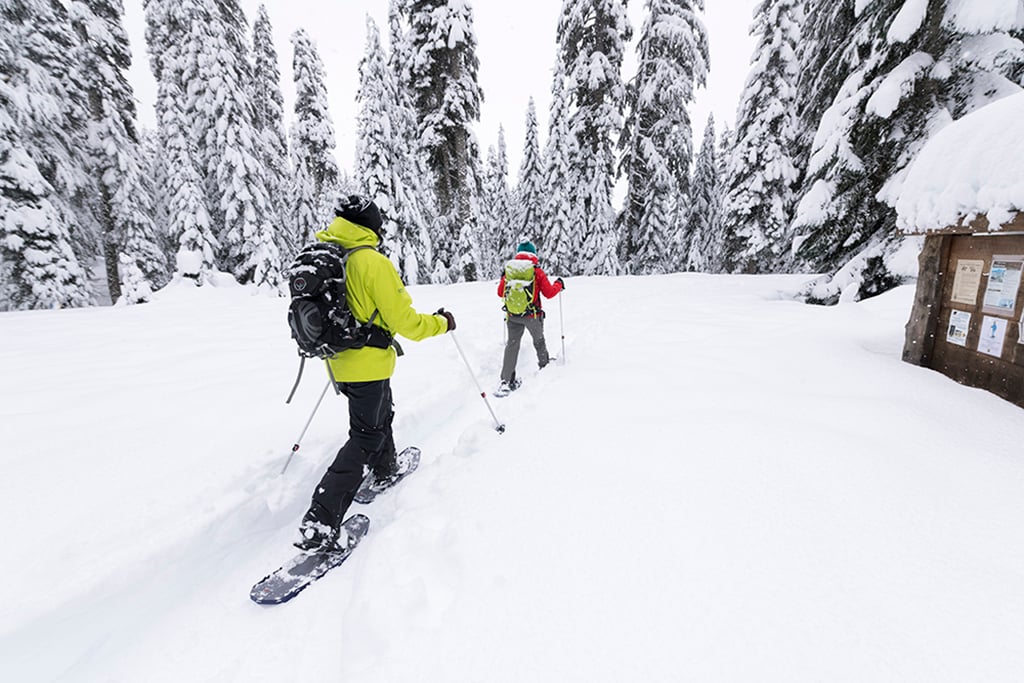
Pack the right gear
As with any adventure, it’s important to pack the 10 Essentials. Here are a few pieces of gear of particular note for snowshoe outings.
- Warm, dry clothes: Remember to dress in non-cotton layers and always bring an extra warm layer for emergencies. Don’t forget the warm hat!
- Food and water: You’ll burn more calories in the winter trying to stay warm, so bring good snacks and lots of water. Food and water are the first line of defense against hypothermia and frostbite.
- Navigation: Without marked trails, you’ll want good navigation tools and to know how to use them (maps, compass, altimeter, GPS).
- Emergency gear: Communication device, shelter, heat (fire starter), and a headlamp. And if you’ll be in avalanche terrain, beacon, probe and shovel
- First aid kit: Anyone traveling through the mountains, winter or summer, should consider taking a Wilderness First Aid course.
- Skin and eye protection: Don’t forget the sunscreen, lip balm, and sunglasses/goggles. Remember, the sun’s reflection off the snow can be extremely bright even with cloudy skies.
Pro tip: Consider a winter-specific backpack. Backs designed to carry avalanche gear offer separate tool pockets, wet-dry dividers, and back-panel access into the main compartment. These features make a winter pack easier to use on snow-based adventures.
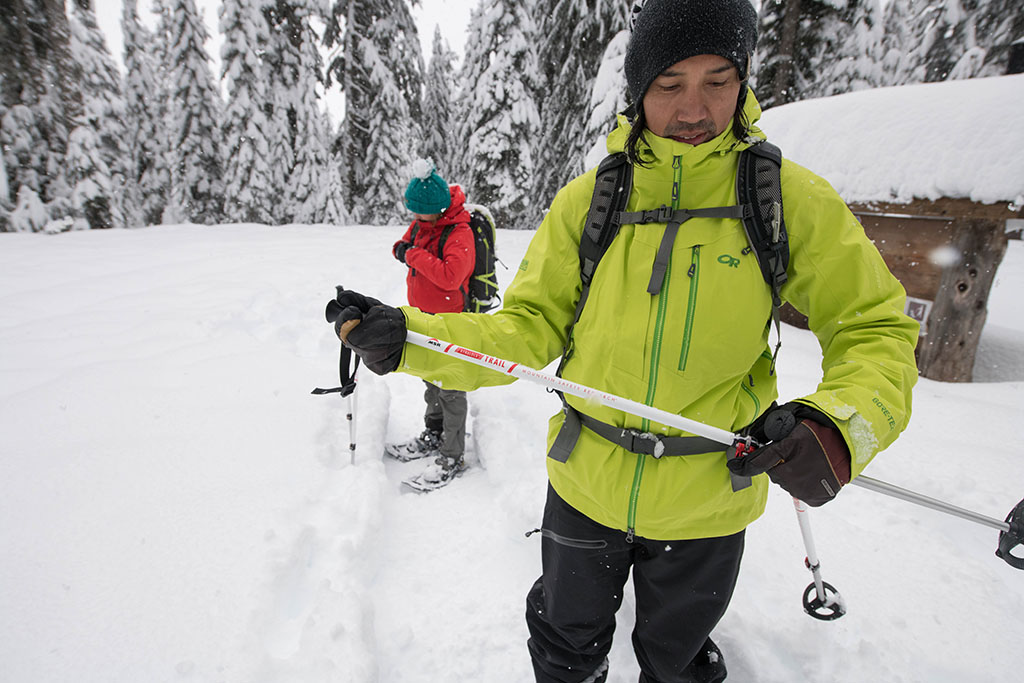
Don’t forget poles
While many hikers forego poles during the summer, as soon as snow covers the ground, poles become essential pieces of gear. Poles not only provide added balance when moving across soft and shifting snow, they can also offer necessary flotation while you wallow in deep powder.
Pro tip: Use larger powder-specific pole baskets during the winter. These will give you better flotation and balance when conditions are soft.
Pro tip: If you fall over in soft snow, place your poles parallel to the surface in an “X”. This will provide more resistance and help you get standing again.
Snowshoeing is a rewarding and accessible winter sport for everyone—one that’s simple and offers the solitude that many of us long for. But it’s important to approach snowshoe adventures with safety at the forefront of your mind. A few easy steps, some intentional learning, and a bit of planning will have you safely enjoying the winter wonderland in your backyard this upcoming season.
